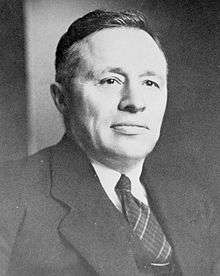James Garfield Gardiner
| The Right Hon. James Garfield Gardiner PC, MP, MLA | |
|---|---|
 | |
| 4th Premier of Saskatchewan | |
|
In office February 26, 1926 – September 9, 1929 | |
| Monarch | George V |
| Lieutenant Governor | Henry William Newlands |
| Preceded by | Charles A. Dunning |
| Succeeded by | James T.M. Anderson |
|
In office July 19, 1934 – November 1, 1935 | |
| Monarch | George V |
| Lieutenant Governor | Hugh Edwin Munroe |
| Preceded by | James T.M. Anderson |
| Succeeded by | William John Patterson |
| Member of the Legislative Assembly of Saskatchewan for North Qu'Appelle | |
|
In office June 25, 1914 – June 19, 1934 | |
| Preceded by | John Archibald McDonald |
| Succeeded by | District abolished |
| Member of the Legislative Assembly of Saskatchewan for Melville | |
|
In office June 19, 1934 – November 1, 1935 | |
| Preceded by | District created |
| Succeeded by | Ernest Walter Gerrand |
| Member of the Canadian Parliament for Assiniboia | |
|
In office January 6, 1936 – March 26, 1940 | |
| Preceded by | Robert McKenzie |
| Succeeded by | Jesse Pickard Tripp |
| Member of the Canadian Parliament for Melville | |
|
In office March 26, 1940 – March 31, 1958 | |
| Preceded by | William Richard Motherwell |
| Succeeded by | James Norris Ormiston |
| Personal details | |
| Born |
November 30, 1883 Farhuquar (South Huron), Ontario |
| Died |
January 12, 1962 (aged 78) Balcarres, Saskatchewan |
| Political party | Saskatchewan Liberal Party |
| Other political affiliations | Liberal Party of Canada |
| Spouse(s) |
Rosetta Jane Gardiner (m. 1912–17), Violet McEwen (m. 1917–44), Isabella (Scott) Christie (m. 1944–62) |
| Profession | Farmer, Educator |
| Religion | United Church of Canada |
James Garfield "Jimmy" Gardiner, PC (30 November 1883 in Farhuquar, Ontario – 12 January 1962 in Balcarres, Saskatchewan) was a Canadian farmer, educator, and politician. He served as the fourth Premier of Saskatchewan, and as a minister in the Canadian Cabinet.
Life and career
Gardiner was first elected to the Legislative Assembly of Saskatchewan in 1914, and served as Minister of Highways (1922–26) in the government of Premier Charles A. Dunning from 1922 until succeeding Dunning as Premier in 1926. A highly partisan Liberal, his government lost its majority in the legislature in the 1929 election due to patronage scandals. Although the Conservative Party had won fewer seats, it was able to defeat the Gardiner government through a motion of non-confidence, then form a "co-operative government" with the support of some Progressive Party and independent Members of the Legislative Assembly.
As Leader of the Opposition, Gardiner accused James Anderson's Conservative government of bigotry, alleging that it was linked with the Ku Klux Klan. Gardiner defeated Anderson in the 1934 election, and became Premier a second time. In 1935 he was involved in negotiations to end the On-to-Ottawa Trek in Regina.
Gardiner left provincial politics later in 1935 to join the federal cabinet of Liberal Prime Minister William Lyon Mackenzie King as Minister of Agriculture. He was elected to the House of Commons a few months later. Gardiner held the agriculture portfolio for twenty-two years until the 1957 federal election when the Liberal government was defeated. He was a powerful figure in both the King and St. Laurent governments.
In 1947, he was sworn into the Imperial Privy Council, allowing him use of the prenominal honorific The Right Honourable.
Gardiner ran for the leadership of the Liberal Party of Canada at the 1948 Liberal leadership convention, but lost to Louis St. Laurent. He remained in the Canadian House of Commons until he lost his seat in the 1958 Diefenbaker sweep.
Gardiner was married three times: first to Rosetta Jane Gardiner in 1912, then to Violet McEwen in 1917 and finally to Isabella (Scott) Christie in 1944. His son James Wilfrid served in the Saskatchewan assembly.[1] The Gardiner family farm was near Lemberg, Saskatchewan.
Incidentally it was Gardiner, who as Premier of Saskatchewan in 1928, championed the Saskatchewan Sanitoria and Hospitals Act – the first legislation to provide free hospitalization and treatment for victims of tuberculosis anywhere in North America. The Act was passed unanimously by the provincial legislature on January 1, 1929. This Act was probably one of his least known legacies to Saskatchewan public policy.[2]
Saskatchewan's Gardiner Dam is named after him.
In 2006, the CBC agreed to pull the movie Prairie Giant: The Tommy Douglas Story from all broadcasts in response to criticism about its portrayals of Gardiner.[3]
References
- James Garfield Gardiner – Parliament of Canada biography
- Encyclopedia of Saskatchewan Entry
- Saskatchewan Archives Board – Saskatchewan Election Results By Electoral Division
- ↑ "James G. Gardiner fonds". Saskatchewan Archival Information Network. Retrieved 2012-06-30.
- ↑ Houston, C. Stuart (1991). "RG Ferguson Crusader against Tuberculosis". Toronto: Hannah Institute & Dundurn Press. p. 82.
- ↑
| Party political offices | ||
|---|---|---|
| Preceded by Charles A. Dunning |
Leader of the Liberal Party of Saskatchewan 1926–1935 |
Succeeded by William John Patterson |